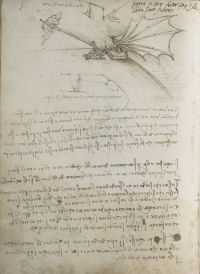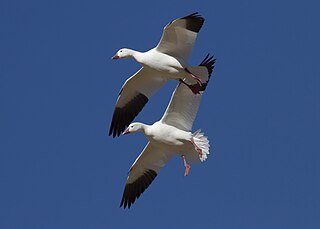 W
WBird flight is the primary mode of locomotion used by most bird species in which birds take off and fly. Flight assists birds with feeding, breeding, avoiding predators, and migrating.
 W
WThis is a list of soaring birds, which are birds that can maintain flight without wing flapping, using rising air currents. Many gliding birds are able to "lock" their extended wings by means of a specialized tendon.Bird of preyBuzzards Condors Eagles Falcons Harriers Hawks Kites Osprey Secretary bird VulturesPasserineChoughs Raven WoodswallowsCranesSandhillHeronsStorksSea birdsAlbatrosses Frigatebirds Gulls Pelicans Petrels Shearwaters TernsExtinctArgentavis
 W
WCertain species of fish and birds are able to locomote in both air and water, two fluid media with very different properties. A fluid is a particular phase of matter that deforms under shear stresses and includes any type of liquid or gas. Because fluids are easily deformable and move in response to applied forces, efficiently locomoting in a fluid medium presents unique challenges. Specific morphological characteristics are therefore required in animal species that primarily depend on fluidic locomotion. Because the properties of air and water are so different, swimming and flying have very disparate morphological requirements. As a result, despite the large diversity of animals that are capable of flight or swimming, only a limited number of these species have mastered the ability to both fly and swim. These species demonstrate distinct morphological and behavioral tradeoffs associated with transitioning from air to water and water to air.
 W
WA number of animals have evolved aerial locomotion, either by powered flight or by gliding. Flying and gliding animals have evolved separately many times, without any single ancestor. Flight has evolved at least four times, in the insects, pterosaurs, birds, and bats. Gliding has evolved on many more occasions. Usually the development is to aid canopy animals in getting from tree to tree, although there are other possibilities. Gliding, in particular, has evolved among rainforest animals, especially in the rainforests in Asia where the trees are tall and widely spaced. Several species of aquatic animals, and a few amphibians and reptiles have also evolved to acquire this gliding flight ability, typically as a means of evading predators.
 W
WBird migration is the regular seasonal movement, often north and south along a flyway, between breeding and wintering grounds. Many species of bird migrate. Migration carries high costs in predation and mortality, including from hunting by humans, and is driven primarily by availability of food. It occurs mainly in the northern hemisphere, where birds are funneled on to specific routes by natural barriers such as the Mediterranean Sea or the Caribbean Sea.
 W
WBird migration is the regular seasonal movement, often north and south along a flyway, between breeding and wintering grounds. Many species of bird migrate. Migration carries high costs in predation and mortality, including from hunting by humans, and is driven primarily by availability of food. It occurs mainly in the northern hemisphere, where birds are funneled on to specific routes by natural barriers such as the Mediterranean Sea or the Caribbean Sea.
 W
WCodex on the Flight of Birds is a relatively short codex from c. 1505 by Leonardo da Vinci. It comprises 18 folios and measures 21 × 15 centimetres. Now held at the Royal Library of Turin, the codex begins with an examination of the flight behavior of birds and proposes mechanisms for flight by machines. Leonardo constructed a number of these machines, and attempted to launch them from a hill near Florence. However, his efforts failed.
 W
WFlight feathers are the long, stiff, asymmetrically shaped, but symmetrically paired pennaceous feathers on the wings or tail of a bird; those on the wings are called remiges, singular remex, while those on the tail are called rectrices, singular rectrix. The primary function of the flight feathers is to aid in the generation of both thrust and lift, thereby enabling flight. The flight feathers of some birds have evolved to perform additional functions, generally associated with territorial displays, courtship rituals or feeding methods. In some species, these feathers have developed into long showy plumes used in visual courtship displays, while in others they create a sound during display flights. Tiny serrations on the leading edge of their remiges help owls to fly silently, while the extra-stiff rectrices of woodpeckers help them to brace against tree trunks as they hammer on them. Even flightless birds still retain flight feathers, though sometimes in radically modified forms.
 W
WFlocking is the behavior exhibited when a group of birds, called a flock, are foraging or in flight.
 W
WAround 350 BCE, Aristotle and other philosophers of the time attempted to explain the aerodynamics of avian flight. Even after the discovery of the ancestral bird Archaeopteryx over 150 years ago, debates still persist regarding the evolution of flight. There are three leading hypotheses pertaining to avian flight: Pouncing Proavis model, Cursorial model, and Arboreal model.
 W
WA V formation is the symmetric V-shaped flight formation of flights of geese, swans, ducks, and other migratory birds, improving their energy efficiency. V formations also improve the fuel efficiency of aircraft and are used on military flight missions.
 W
WWhiffling is a term used in ornithology to describe the behavior whereby a bird rapidly descends with a zig-zagging, side-slipping motion. Sometimes to whiffle, a bird flies briefly with its body turned upside down but with its neck and head twisted 180 degrees around in a normal position. The aerodynamics which usually give a bird lift during flying are thereby inverted and the bird briefly plummets toward the ground before this is quickly reversed and the bird adopts a normal flying orientation. This erratic motion resembles a falling leaf, and is used to avoid avian predators or may be used by geese to avoid a long, slow descent over an area where wildfowling is practised.
 W
WA wing is a type of fin that produces lift, while moving through air or some other fluid. As such, wings have streamlined cross-sections that are subject to aerodynamic forces and act as airfoils. A wing's aerodynamic efficiency is expressed as its lift-to-drag ratio. The lift a wing generates at a given speed and angle of attack can be one to two orders of magnitude greater than the total drag on the wing. A high lift-to-drag ratio requires a significantly smaller thrust to propel the wings through the air at sufficient lift.